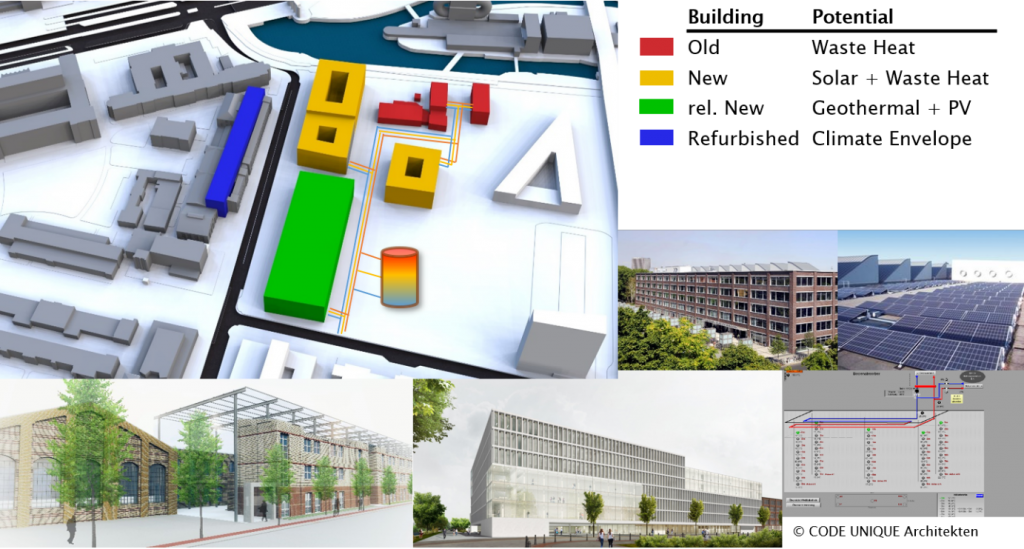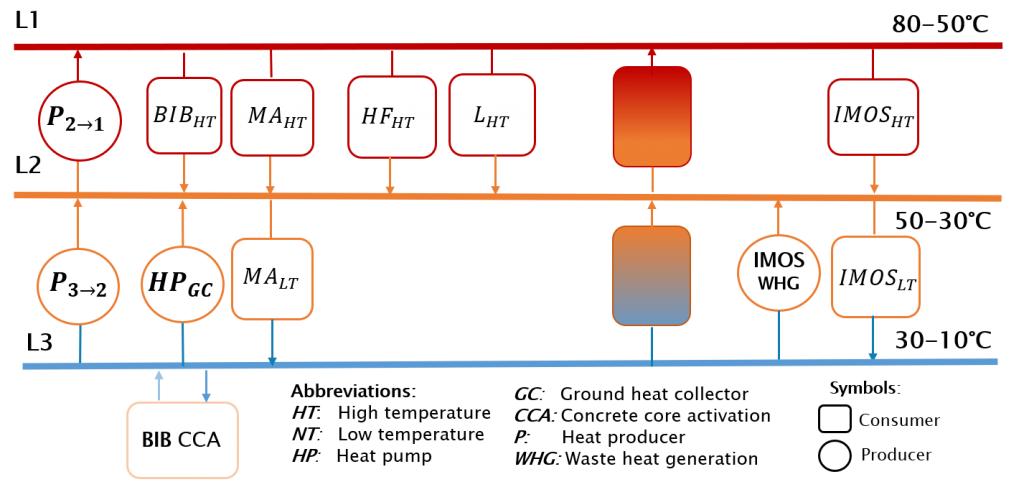With the construction of two new buildings (Mathe and IMoS) on the eastern campus of the TU Berlin, this area will contain a heterogenous mix of buildings with different age classes, usage profiles and energy potentials, turning it into a perfect test case for innovative energy systems. The new buildings will meet the current BNB and EnEV standards and thus have low specific heating demands and low temperature floor heating systems. In addition to the PV-suitable roof surfaces, these buildings also offer a considerable waste heat potential from data centers. The neighboring University Library, built in 2004, has high heating and cooling requirements met by a variety of HVAC systems with different temperature levels. Its geothermal collector, currently out of order due to the high underground temperatures, presents with a heating and cooling potential of ca. 300 MWh/year. The unrefurbished laboratory buildings HF and L, with their high temperature heat demands and sporadic waste heat potentials, complete the picture of an energetically diverse city district, making it a perfect demonstrator for innovative district heating systems.

In this context, the goal of this project is to design and build a multilevel heating network connecting the 5 buildings which would promote the efficient usage of decentralized renewable heat sources and testcase the integration of ‘prosumers’ into district heating systems. To this purpose, a concept of a cascading 3-level heating network has been developed by the HCBC Team in cooperation with Vattenfall Berlin Wärme AG (see figure below). As opposed to conventional high temperature district heating networks, a cascading multilevel approach with low, medium, and high temperature levels allows the direct integration of renewable energy sources and minimizes thermal and exergy losses. In this concept, the high-temperature consumers (AC systems and heating systems of old buildings) are supplied from the high-temperature level (L1). The return flow of these consumers is injected into the medium temperature level (L2) which supplies the floor heating systems of the new buildings. The surplus waste heat of the data centers and of the ground collector under the library are also injected in the medium temperature level, covering almost the entirety of the low temperature demand. The third level (L3) collects the return flows of the low temperature consumers and supplies the concrete core activation system of the library. Moreover, water tanks are envisaged for the short-term storage of surplus renewable heat and for the load management of the network.

A digital twin of this district heating prototype has been developed at the Hermann-Rietschel-Institute and will be used for the design and optimization of the network as well as for assessing different control strategies. Preliminary results of the analysis show a potential of 50% reduction in primary energy consumption and CO2 emission savings of up to 200 tonnes/year compared to a supply through the conventional high-temperature municipal district heating.
The economic and technical feasibility of this concept are currently being assessed, with construction planned to start next year. A test and monitoring phase will follow in which the operation of the system and its individual components will be optimized. Finally, strategies for the efficient integration of decentralized renewable energies into district heating systems and for the design and control of multilevel DHC networks at a larger scale will be developed.
Author & contact: Dipl.-Ing. Diana Stanica (diana.stanica@tu-berlin.de)
NEWSLETTER ABONNIEREN
Um über Neuigkeiten auf dem Blog informiert zu werden, können Sie sich hier mit Ihrer E-Mail-Adresse für den Newsfeed registrieren. Sie werden dann per E-Mail benachrichtigt, wenn neue Newseinträge veröffentlicht werden.
